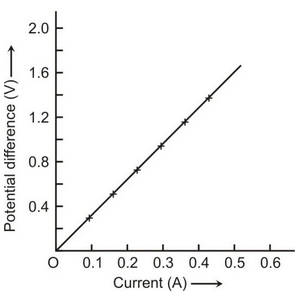
Definition And Formula Of Ohm's Law
Ohms Law is a fundamental principle in electrical engineering and physics that describes the relationship between voltage (V), current (I), and resistance (R) in an electrical circuit. It is named after the German physicist Georg Simon Ohm, who formulated this law in the early 19th century. Ohm's Law is expressed mathematically as: V = I*R Where: - V represents voltage, measured in volts (V). - I represents current, measured in amperes (A). - R represents resistance, measured in ohms (Ω). This simple formula provides a foundation for understanding and analyzing electrical circuits. In this explanation, we will delve into each component of Ohm's Law and discuss its significance in practical applications.
Also Check - Thermodynamics Formula
Voltage (V): Voltage is a measure of electrical potential difference between two points in a circuit. It is often compared to the pressure in a water pipe. The unit of voltage is the volt (V), named after Alessandro Volta, another notable physicist in the field of electricity. Voltage provides the driving force that pushes electric charge (electrons) through a circuit. In practical terms, voltage represents the energy per unit charge available to move electrons in the circuit. A higher voltage implies more energy and a greater potential for current flow.Also Check - Work, Energy & Power Formula
Current (I): Current refers to the flow of electric charge within a circuit. It is measured in amperes (A), which is named after André-Marie Ampère, a pioneer in the study of electromagnetism. Current is the rate at which charge flows through a conductor and is often compared to the flow rate of water in a pipe. In an electrical circuit, electrons move from a region of higher voltage (positive terminal) to a region of lower voltage (negative terminal), creating a current flow. The direction of current flow is conventionally considered from positive to negative, even though electrons actually move in the opposite direction.Also Check - Unit, Dimension & Vector Formula
Resistance (R): Resistance is a property of materials that opposes the flow of electric current. It is measured in ohms (Ω), named after Georg Simon Ohm himself. Resistance can be thought of as the restriction or hindrance encountered by electrons as they move through a conductor. Materials with high resistance impede the flow of current, while materials with low resistance allow for easier current flow. Resistance is influenced by various factors, including the material's composition, temperature, and physical dimensions. It plays a crucial role in determining the behavior of electrical circuits.Ohm's Law in Practice:
Ohm's Law is particularly useful in analyzing and designing electrical circuits. It helps engineers and technicians calculate and predict voltage, current, and resistance in various components of a circuit.- Calculating Voltage (V): If you know the current (I) and resistance (R) in a circuit, you can use Ohm's Law to calculate the voltage (V) across the circuit element. This is done by multiplying the current by the resistance:
- Calculating Current (I): Conversely, if you know the voltage (V) across a circuit element and its resistance (R), you can calculate the current (I) using Ohm's Law:
- Calculating Resistance (R): If you know the voltage (V) and current (I) in a circuit, you can determine the resistance (R) using Ohm's Law:
Also Check - Heat Transfer Formula
Applications of Ohm's Law:
Ohm's Law is not limited to theoretical concepts; it has numerous practical applications in various fields:- Electronics: Ohm's Law is fundamental in designing and troubleshooting electronic circuits, ensuring that components operate within safe limits.
- Electrical Engineering: Engineers use Ohm's Law for power distribution, electrical safety, and designing circuits in various applications, from power generation to consumer electronics.
- Electricians: Electricians rely on Ohm's Law to determine the appropriate wire size, fuses, and circuit breakers for electrical installations.
- Physics: Ohm's Law plays a vital role in the study of electromagnetism and is a fundamental concept in understanding electrical phenomena.
- Battery Technology: Ohm's Law is essential in battery design and management, ensuring safe charging and discharging rates.
Ohm's Law FormulaFAQs
What is Ohm's Law?
Ohm's Law is a fundamental principle in electricity that relates voltage (V), current (I), and resistance (R) in a circuit through the equation \(V = I * R).
Why is Ohm's Law important?
Ohm's Law is crucial because it helps us understand and predict how electricity behaves in circuits, making it essential for designing and troubleshooting electrical systems.
What are the units for voltage, current, and resistance?
Voltage is measured in volts (V), current in amperes (A), and resistance in ohms (Ω).
Does Ohm's Law apply to both AC and DC circuits?
Yes, Ohm's Law applies to both AC and DC circuits, although it's more complex in AC circuits due to varying impedance and phase differences.
🔥 Trending Blogs
Talk to a counsellorHave doubts? Our support team will be happy to assist you!

Check out these Related Articles
Free Learning Resources
PW Books
Notes (Class 10-12)
PW Study Materials
Notes (Class 6-9)
Ncert Solutions
Govt Exams
Class 6th to 12th Online Courses
Govt Job Exams Courses
UPSC Coaching
Defence Exam Coaching
Gate Exam Coaching
Other Exams
Know about Physics Wallah
Physics Wallah is an Indian edtech platform that provides accessible & comprehensive learning experiences to students from Class 6th to postgraduate level. We also provide extensive NCERT solutions, sample paper, NEET, JEE Mains, BITSAT previous year papers & more such resources to students. Physics Wallah also caters to over 3.5 million registered students and over 78 lakh+ Youtube subscribers with 4.8 rating on its app.
We Stand Out because
We provide students with intensive courses with India’s qualified & experienced faculties & mentors. PW strives to make the learning experience comprehensive and accessible for students of all sections of society. We believe in empowering every single student who couldn't dream of a good career in engineering and medical field earlier.
Our Key Focus Areas
Physics Wallah's main focus is to make the learning experience as economical as possible for all students. With our affordable courses like Lakshya, Udaan and Arjuna and many others, we have been able to provide a platform for lakhs of aspirants. From providing Chemistry, Maths, Physics formula to giving e-books of eminent authors like RD Sharma, RS Aggarwal and Lakhmir Singh, PW focuses on every single student's need for preparation.
What Makes Us Different
Physics Wallah strives to develop a comprehensive pedagogical structure for students, where they get a state-of-the-art learning experience with study material and resources. Apart from catering students preparing for JEE Mains and NEET, PW also provides study material for each state board like Uttar Pradesh, Bihar, and others
Copyright © 2025 Physicswallah Limited All rights reserved.
Get App









